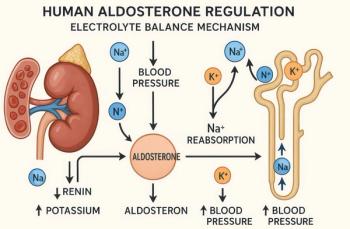
Hemopericardium and Tamponade
The patient with hypertension and syncope had cardiac tamponade. Causes, symptoms, and treatment described here.
A 65-year-old man with a history of hypertension was brought to the emergency department by ambulance for a syncopal episode that occurred at a restaurant. His initial blood pressure was in the low 80s but improved to 105/80 after a 500 mL IV saline bolus. His only complaint other than feeling generally weak was being “sweaty.” He denied any injury, pain, fever, vomiting, melena, or shortness of breath and said he had been fine all day until he suddenly got sweaty and passed out.
On exam, the patient was diaphoretic but afebrile with a pulse of 98, a BP of 86/51, a respiratory rate of 20, and a pulse-ox of 95% on room air. Head and neck exam were normal except for mild jugular venous distention (JVD). The patient had normal heart and lung sounds and no abdominal tenders or leg edema.
The initial EKG showed a normal sinus rhythm at 92 with very slight ST depression in the lateral leads. A portable chest x-ray, shown below, was read by the radiologist as normal.
The patient’s BP continued to drop, and he became more diaphoretic. This time his vital signs did not respond to fluids. A bedside ultrasound was done to evaluate for hypovolemia, massive pulmonary embolism, or cardiac tamponade but showed only a small pericardial effusion. A norepinephrine drip was started for fluid refractory hypotension.
Questions 1 & 2: Do you agree with the radiologist’s read of the chest x-ray? What should be your next test?[[{"type":"media","view_mode":"media_crop","fid":"60337","attributes":{"alt":"","class":"media-image","id":"media_crop_7585182130467","media_crop_h":"0","media_crop_image_style":"-1","media_crop_instance":"7619","media_crop_rotate":"0","media_crop_scale_h":"0","media_crop_scale_w":"0","media_crop_w":"0","media_crop_x":"0","media_crop_y":"0","style":"height: 390px; width: 428px; border-width: 0px; border-style: solid; margin: 5px;","title":" ","typeof":"foaf:Image"}}]]
Answers 1 & 2: The mediastinum here is actually borderline in width. A CT of the chest should be ordered.
What does the CT scan show? What is the treatment?[[{"type":"media","view_mode":"media_crop","fid":"60338","attributes":{"alt":"","class":"media-image media-image-right","id":"media_crop_8187185106153","media_crop_h":"0","media_crop_image_style":"-1","media_crop_instance":"7620","media_crop_rotate":"0","media_crop_scale_h":"0","media_crop_scale_w":"0","media_crop_w":"0","media_crop_x":"0","media_crop_y":"0","style":"height: 389px; width: 430px; border-width: 0px; border-style: solid; margin: 5px; float: right;","title":" ","typeof":"foaf:Image"}}]]
Answer: CT scan shows a type A aortic dissection causing hemopericardium and tamponade. (DA, descending aorta)[[{"type":"media","view_mode":"media_crop","fid":"60340","attributes":{"alt":"","class":"media-image media-image-right","id":"media_crop_1419967635564","media_crop_h":"0","media_crop_image_style":"-1","media_crop_instance":"7621","media_crop_rotate":"0","media_crop_scale_h":"0","media_crop_scale_w":"0","media_crop_w":"0","media_crop_x":"0","media_crop_y":"0","style":"height: 388px; width: 430px; border-width: 0px; border-style: solid; margin: 5px; float: right;","title":" ","typeof":"foaf:Image"}}]]
Thoracic surgery was paged, but the patient decompensated, so an emergent pericadiocentesis was performed and ~60 mL of blood was aspirated with immediate improvement in vital signs. The catheter was hooked up to a gravity drainage bag and another ~60 mL drained over the next few minutes. Vasopressors were stopped and beta blocker + nitroprusside therapy was initiated in an attempt to prevent worsening of the dissection. The surgeon arrived to take the patient to the OR. The patient survived.
Discussion
Cardiac tamponade is a surgical emergency that requires pericardial drainage, usually by pericardiocentesis but occasionally in the OR with a thoracic surgeon. Causes of cardiac tamponade are basically the same as the causes of pericarditis. The most common causes are idiopathic, infection, and malignancy (see nonhighlighted part of Chart below for other causes).
Categorizing tamponade as acute or subacute can be useful. Acute tamponade typically is caused by bleeding from trauma or aortic dissection; subacute tamponade typically is caused by an exudative effusion from infection, malignancy, uremia, or another cause.
Symptoms of tamponade usually are just dyspnea or generalized weakness or both, but chest pain, syncope, or other symptoms also may occur. In acute tamponade, symptoms are more likely to present abruptly, as in this case.
Be aware that aortic dissection can cause pericarditis and therefore perfectly mimic pericarditis. Signs in tamponade usually include tachycardia, JVD, and pulsus paridoxus.
Low blood pressure occurs late and is an ominous sign. Bradycardia is rare unless the cause is aortic dissection. Beck’s triad of hypotension, JVD, and low BP is not useful clinically because hypotension is rare until late in the course and soft heart sounds are neither sensitive nor specific.
The test of choice to diagnose cardiac tamponade is a bedside echocardiogram (echo). In subacute cases, chest x-ray and EKG can be useful. CXR often shows an enlarged “water bottle”–shaped heart, and EKG often shows low voltage.
In acute tamponade, CXR and EKG are frequently normal, because the pericardium gradually stretches in subacute cases, allowing volumes up to or exceeding a liter to accumulate before tamponade occurs. There is no time for the pericardium to stretch in acute cases, so tamponade occurs more rapidly and with much lower volumes of pericardial fluid.
In acute cases, death usually occurs within hours if the blood is not drained and the cause not treated. In subacute cases, fluid can gradually accumulate for days to weeks or more before causing instability.
Treatment of tamponade usually is with bedside ultrasound guided pericardiocentesis. If this is not successful, a pericardial window can be done. In acute cases, thoracotomy in the OR usually is required to both drain the pericardium and repair the source of bleeding.
Excerpt on CARDIAC TAMPONADE from
[[{"type":"media","view_mode":"media_crop","fid":"60343","attributes":{"alt":"","class":"media-image","id":"media_crop_6168092791001","media_crop_h":"0","media_crop_image_style":"-1","media_crop_instance":"7623","media_crop_rotate":"0","media_crop_scale_h":"0","media_crop_scale_w":"0","media_crop_w":"0","media_crop_x":"0","media_crop_y":"0","title":" ","typeof":"foaf:Image"}}]]
Click on image for additional details
[[{"type":"media","view_mode":"media_crop","fid":"60344","attributes":{"alt":"","class":"media-image media-image-left","id":"media_crop_8397426721584","media_crop_h":"0","media_crop_image_style":"-1","media_crop_instance":"7624","media_crop_rotate":"0","media_crop_scale_h":"0","media_crop_scale_w":"0","media_crop_w":"0","media_crop_x":"0","media_crop_y":"0","style":"height: 243px; width: 190px; border-width: 0px; border-style: solid; margin: 5px; float: left;","title":" ","typeof":"foaf:Image"}}]]
Newsletter
Enhance your clinical practice with the Patient Care newsletter, offering the latest evidence-based guidelines, diagnostic insights, and treatment strategies for primary care physicians.



